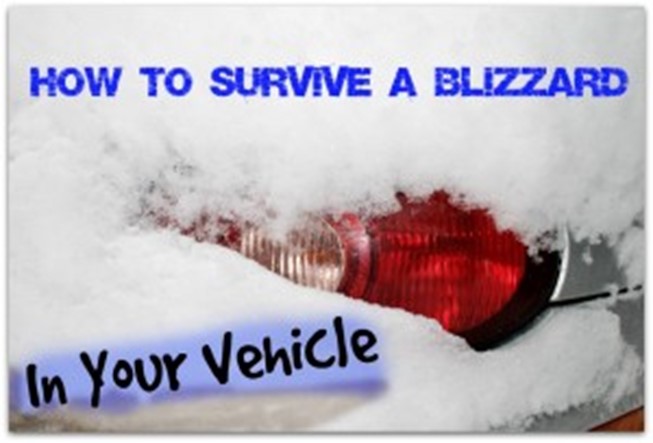
How do you survive if you become trapped in your vehicle during a blizzard? With winter fast approaching, this is a good question.
The last few years have seen unseasonably cold and snowy winters in the U.S. Along with sustained cold temperatures, many regions experienced blizzard conditions including heavy snow fall and accumulation, combined with strong winds. Numerous areas were affected, including thousands of miles of roads ranging from major commuter highways down to narrow, twisty mountain roads. This became a recipe for motorists getting stuck in their vehicles during these tough weather conditions and they did.
Blizzards and winter storms are generally forecast by our nation’s weather services. What is not easily predicted is the true amount of snow, wind speeds, and the areas where snow and ice will accumulate.
This means that if you live in or are traveling through to an area that gets winter snow storms, regardless of whether it is urban, suburban or rural, you need to be prepared.
Here’s how.
Winterize Your Vehicle, personal gear and emergency equipment
Your Vehicle
- Get your vehicle winterized including, engine, radiator and windshield washer fluids. Don’t forget new wiper blades as well.
- Have your battery checked.
- Get your tires checked. Do they have enough tread to last the winter or do you need to change them for all season or snow tires?
- Put your tire chains or traction mats in the trunk.
- Print out this free download of what you should keep in a vehicle emergency kit.
Emergency Equipment
- Verify that you have a windshield scraper, tow rope, jumper cables, flares, or portable emergency roadway lights. If you have a larger vehicle, in particular, make sure your tow rope is up to the task. You don’t want a 10,000 lb. rated tow rope to pull out an Escalade, but you don’t need a 30,000 lb. one for a VW Bug.
- Include a small folding shovel and bag of sand or cat litter (the old cheap kind, not the newer clumping kind) in case you get stuck and need to dig out or provide extra traction for your tires.
- Check your first aid kit and replenish any used supplies.
- Additional items can be found at Ready.gov
Personal Gear
- Winterize your emergency gear with a couple of space blankets as well as one wool blanket or sleeping bag. The cheap mylar space blankets are great to have, but they rip easily so you might want to splurge on the reusable, higher-quality ones to keep in your car.
- Make sure your emergency kit includes, among other things, glow sticks, knife or multi-tool, duct tape, flashlight, extra batteries, a lighter, matches, candles for melting snow, pen and paper.
- It’s important to have a metal cup or can for melting snow into water. Even an empty soup can will do, provided it’s metal. Most H2O containers will freeze once your vehicle cools down.
- Store some extra water and high energy foods or snacks like protein bars in the vehicle.
- Pack a small gear bag with extra clothing. Jacket, hat, socks, and gloves are a minimum – preferably wool or something high tech and waterproof. If you dress up for work, add a complete change of appropriate winter clothing, including snow boots. I also add in a couple packs of chemical hand and foot warmers.
If You Become Stranded
First and foremost, keep calm and stay focused on what you need to do to survive.
Stay With Your Vehicle
It is much easier to spot a vehicle than it is a person. Only leave to seek help if you have 100 yards (a football field) of visibility or more and you have a clear, visible objective to go for. Do not just get out and start walking along the road way hoping someone will find you. That is a good way to freeze to death, literally.
Make Your Car as Visible as Possible, Quickly!
Turn on your emergency flashers and dome lights while your engine is running. Tie something bright, like a bandanna, to your antenna or roof rack, if you have one, or hang something bright out a window. If you have glow sticks, put one in both your front and back windows. This will make your vehicle (and you) much more visible, even when it is snowing and blowing heavily. Finally, when the snow has stops, raise the hood of your car.
Call 911 and a Friend
After you are sure you are stuck and in danger of being snowed in, do not hesitate to call 911. Answer all questions and follow all directions given by the 911 operator. Your life may literally depend on it.
After your 911 call, or if you can’t get through to the operator, contact a family member or friend and give them the details of what has happened to you. If you haven’t reached emergency services, have them call for you. Remember, you are in a blizzard and who knows how long phone service will stay up or the battery in your phone will last.
Stay Warm
Turn on your engine for 10 minutes every hour and run the heater at full blast. (Keep your tailpipe clear of snow.) At the same time, crack open a downwind window just a little to let in fresh air and prevent carbon monoxide build up.
Put on extra clothing if you have it, especially a jacket, hat, socks, and gloves (see above). Do you have a winter emergency kit in your vehicle? If so, take out the space blanket, wool blanket, and / or sleeping bag and wrap it around you. If you have all or some of these coverings, layer up. Use them all, but not to the point of over heating.
If you don’t have a winter emergency kit, use things like maps, magazines, newspapers and even removable car mats for insulation under and around you.
If you are traveling with someone snuggle up, huddle, and share the body heat.
Move
OK, so it is a little hard to run in place in most vehicles. But it is important for mind and body to keep your blood circulating and muscles from stiffening up. You can clap your hands and stomp your feet. Move your arms and legs. Do isometric exercises and don’t stay in any one position for very long.
Fuel Your Body
Eat and drink regularly. Not a lot, just snack, so that you body doesn’t pull too much blood from your extremities to digest your food.
Beware!
If you are stuck for any prolonged period of time, there are three things to be on guard for: carbon monoxide poisoning, hypothermia, and frostbite. The good news is these threats are fairly easily dealt with if you take action to protect yourself, as soon as possible. Keep a window slightly open periodically (usually when you run your vehicle engine) to allow just a little fresh air in. This will combat carbon monoxide build up. As for hypothermia and frostbite, layer up with your extra clothing and coverings, keep moving (see above), take in liquids and food frequently and in small amounts-snack. Stay moving and stay fueled!

Keep Motivated and Focused
The longer you are stuck in your vehicle, the easier it becomes be to get demotivated, thinking help will never come. It is vital that you keep a positive mental attitude. This one thing will strengthen your will to live. Stay focused on the positive things you need to do to promote your rescue and your survival. Attitude is everything in survival. Like the will to live, keeping and cultivating a positive mental attitude (PMA) is central to your success. I would wager more emergencies have gone from bad to worse because of a lack of PMA, usually caused by fear and panic followed by depression and apathy.
Things to do to promote a positive mental attitude, defeat fear and control panic as well as ward off depression and the onset of hopelessness and apathy:
- Once you deal with any immediate and urgent safety or medical issues, Stop! Take a moment and be still.
- Focus on your breathing. Breathe slowly and deeply. This promotes relaxation and helps reduce anxiety.
- Slow down your thinking. Focus on positive thoughts and feelings. Fear and panic are at their strongest when your mind is racing and your imagination is running rampant with negative thoughts and ideas. Drive these thoughts from your mind.
- Create your survival plan. Focus on what you need to do to survive.
- Get busy and be proactive. Concentrate on the fundamental things you need to do and keep doing while you are stuck in your vehicle.
- Improvise: Be willing to think outside the box as you create your survival plan and act on it. Look around and be creative in the use of your resources at hand.
- Adapt: A blizzard means COLD! Adjust to your circumstances and surroundings, possibly including huddling for warmth with people you normally, literally keep at arms length. Be willing and able to tolerate discomfort. . Know your strengths and weaknesses: mental, emotional, and physical. Push your limits, endure what is necessary, and make “I will survive” your mantra. Stay Strong.
The vast majority of survival events, including getting stuck in a blizzard are short lived – less than 24 hours. That said, during any major weather event including blizzards, road crews, law enforcement, and sometimes even rescue teams are out looking for stranded motorists. However, there is a lot you can do to help keep yourself safe and alive until help arrives or you are able to rescue yourself. Remember, first and foremost, you are responsible for your safety and survival.
Additional Resources
Pamphlets and Checklists
Winter Survival Brochure
Car Checklist for Winter Survival
Winter Driving Tips
AAA Winter Driving Tips
News Clip
What do You Need in Your Car to Survive a Winter Storm
Start now to make sure you are staying prepared.
Via : thesurvivalmom








 Follow
Follow
